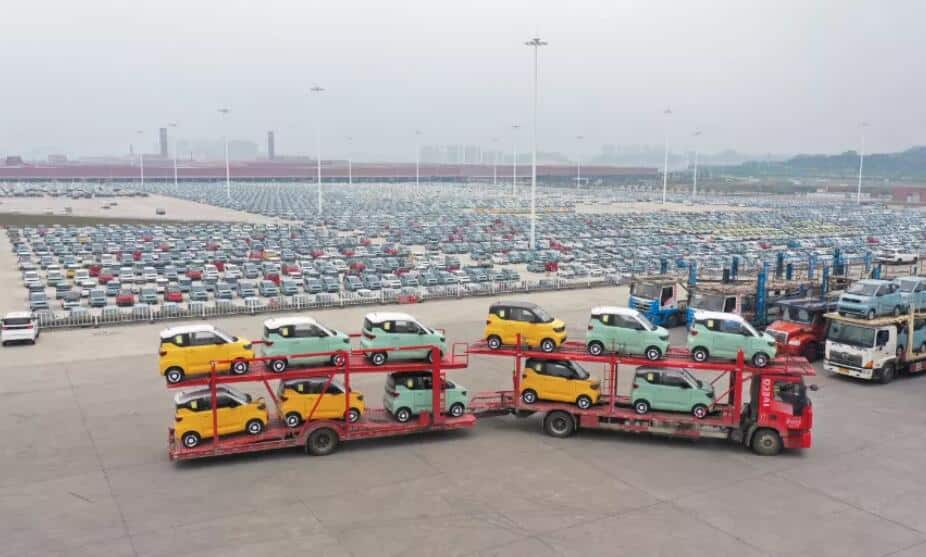The Wuling Hongguang Mini EV's annual sales of more than 310,000 units attest to the potential of miniature electric vehicles in China, attracting companies including Ora to join the competition one after another.
In the first half of this year, cumulative sales of A00-class electric cars in China were 327,800 units, accounting for 32.5 percent of the new energy vehicle market share, up from 26 percent last year. That's three times the number of A-class EVs and more than twice the number of B-class EVs.
As China tightens regulations on low-speed EVs, widely known as "老头乐" (Old Man's Joy), mini EVs are seen as the most suitable alternative.
From 2021-2023, adjustments to policies for low-speed EVs could bring vehicle sales of up to 9 million units, which is expected to contribute RMB 100 billion ($15.4 billion) in revenue to new energy vehicle companies, according to China EV100.
In the first half of this year, the top three EV sales in China were Hongguang Mini EV, Model 3 and Model Y, meaning that low-end and mid-range and high-end products are hot, and the middle market is considered an opportunity for new entrants.
Specifically, in the RMB 50,000-200,000 price range between Wuling Hongguang and Tesla, RMB 100,000-200,000 is the area some mainstream car companies are targeting for their A-B class EVs, while the RMB 50,000-100,000 range is the best market for mini EVs.
In the span of half a month, five car companies launched products in this market, including Letin Mango Hunan TV co-branded model, Sehol E10X, Ora White Cat/ Black Cat facelift, SiTech Sunny Shin-chan, BYD Dolphin.
SAIC-GM-Wuling said on Wednesday that its Baojun KiWi EV had more than 3,000 units ordered within a week of the start of pre-sale.
The Letin and Sehol are priced as low as RMB 30,000 and compete directly with the Hongguang Mini EV.
Sehol, the joint venture brand of JAC and VW, has previously launched new energy products priced above RMB 130,000, and the launch of the E10X shows its ambition to capture the low-cost EV market.
Ora and SiTech's new vehicles are more expensive than the Hongguang Mini EV, meaning they rival the Baojun KiWi EV, which starts at RMB 69,800.
At RMB 96,800 - 124,800, the BYD Dolphin is more expensive than the Baojun KiWi EV, but its design and specs have the potential to be a new option for a mini EV upgrade.
It is worth noting that the biggest reason for the Hongguang Mini EV's success is believed to be its extremely low price, but such cost control is not possible for all car companies.
When rumors previously circulated that Nio would join the mini EV competition, some experts said this was impossible from a supply chain perspective, as many car companies, including Nio, could not do so at the same low cost as the Hongguang Mini EV.
William Li, founder, chairman and CEO of Nio, said in last Thursday's second-quarter conference call that the company would not enter the Mini EV market, although the new brand is aimed at the mass market.
The low selling price of Hongguang Mini EV is partly due to the advantage SAIC-GM-Wuling has accumulated in the supply chain, and partly because of the low profit to earn new energy credits.
Mini EVs are moving toward boutique, which means there may be a larger market for products in the slightly higher price range.
The Ora Black Cat and Chery eQ1 (Small Ant) performed well in the first half of the year, trading at RMB 64,700 and RMB 60,500.
Ora's differentiated layout targeting female consumers can help its products gain a quick foothold while avoiding direct competition with the Hongguang Mini EV and Baojun KiWi EV.
From January to July this year, Ora's cumulative sales were 60,000 units, up 378.4 percent year-over-year, and 70 percent of Ora Black Cat users are urban women.
Sehol and Baojun KiWi EV are also targeting female consumers in their promotions, while BYD Dolphin is touting its intelligent driver assistance system in hopes of fitting in with consumer demand.
Mini EVs have reached an average range of 300 or even 400 km and reverse radar is installed by default, meaning car companies are facing the challenge of new technology in this low-cost market.

